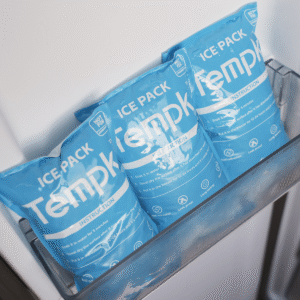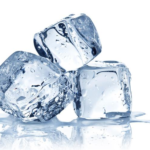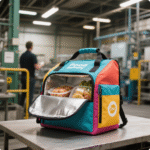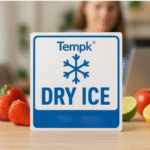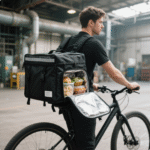Dry Ice Packs for Shipping Dairy Products: How‑To
If you need reliable cold chain control, dry ice packs for shipping dairy products keep ice cream solid and cheeses safe through long transits. Em 2025, you must use vented packaging and mark the net dry ice weight (UN 1845); USPS Air limits many parcels to 5 lb de gelo seco. This guide gives you a one‑minute sizing method, compliant labels, and packouts that cut spoilage and claims.
-
How dry ice packs for shipping dairy products meet safety, labeling, and carrier rules
-
How much dry ice to use with a 60‑second estimator (rule‑of‑thumb and variables)
-
When to choose gel/PCM vs.. dry ice for soft and hard dairy products
-
Step‑by‑step packout that reduces leaks, breakage, and CO₂ risks
-
2025 updates: IATA DGR 66th Addendum, FSMA 204 timing, GS1 Digital Link trends
What makes dry ice packs for shipping dairy products safe and compliant?
Use vented packaging, label UN 1845, and mark net dry‑ice mass on the outer box. U.S. PONTO (49 CFR 173.217) requires venting to prevent pressure build‑up and visible net dry‑ice weight; IATA clarifies that operators may need the weight at booking to respect aircraft limits. USPS Air commonly caps parcels at ≤ 5 lb de gelo seco. Wear gloves and ventilate workspaces due to CO₂ exposure limits (TWA 5,000 ppm; STEL 30,000 ppm).
Plain‑English take: your box must “breathe,” show UN 1845 + net kg, and stay within carrier limits. That keeps your dairy cold e your shipment legal. For ice cream, pack to stay below 0 °F (‑18 °C); for milk and yogurt, hold ≤ 40 °F (4 °C).
Which temperatures do different dairy items need?
Details that matter: ice cream tolerates little heat; soft cheeses risk pathogen growth above 40 °F; some hard cheeses travel warmer. Choose dry ice, pacotes de gel, ou PCMs (phase‑change materials) by temperature target and hold time. PCMs can keep 2–8 °C without freezing sensitive items.
| Dairy segment | Target temp | Best coolant | Why it matters | What it means for you |
|---|---|---|---|---|
| Sorvete / frozen novelties | ≤ 0 °F (‑18 °C) | Gelo seco | Texture degrades fast if warmed | Use dry ice above & around product; pre‑chill shipper. |
| Leite, yogurt, kefir | 32–40 °F (0–4 °C) | Gel/PCM 0–5 °C | Avoids accidental freezing | Choose PCM bricks labeled 2–8 °C to reduce freeze shock. |
| Macio & semi‑soft cheeses | 34–45 °F (1–7 °C) | Gel/PCM; add small dry‑ice topper for heat waves | Pathogen risk rises > 40 °F; keep inside safe window | Use data‑loggers for proof of compliance. |
| Hard / ripened cheeses (select) | 46–55 °F (8–13 °C) | Cool‑PCM (10–12 °C) | Prevents sweating; preserves rind | Ship during mild weather; avoid freezing. |
Practical packing tips
-
Separate product from dry ice with a liner; allow CO₂ to vent.
-
Place dry ice on top of items (cold air sinks) and fill voids to reduce sublimation.
-
Never seal dry ice in an airtight container; keep work areas ventilated.
Real‑world example: A boutique creamery shipping 6 pints across two summer days used a 22‑qt EPS shipper, 9–10 lb de gelo seco (principal + lados), and a PCM liner to protect lids. Product arrived fully frozen with labels showing UN 1845 and net kg. (Process modeled from best‑practice packouts.)
How many dry ice packs for shipping dairy products are enough?
Start with the rule‑of‑thumb: plan on 5–10 lb of dry ice per 24 hours for a well‑insulated cooler; adjust for box size, ambient heat, isolamento, and whether you also use PCM.
Quick estimator (60 segundos):
-
Transit time (horas) ÷ 24 × 7 lb = base dry‑ice need.
-
Add 25% for hot weather or thin boxes; subtract 25% if using VIP panels.
-
Round up to the nearest whole pound and convert to kg for labels (1 kg = 2.2 lb).
Why it works: typical sublimation in well‑insulated coolers is 5–10 lb/day. Placing dry ice on and around product improves hold time.
Can you combine dry ice with gel/PCM?
Sim. For mixed carts (sorvete + queijo), put gel/PCM near items that must not freeze and gelo seco toward frozen goods. PCMs can narrow temperature swings and reduce the amount of dry ice you need.
How do you pack dry ice packs for shipping dairy products step‑by‑step?
Core steps (do this every time):
-
Pre‑chill the insulated shipper and the product.
-
Line box with a poly liner; add bottom insulation pad.
-
Load dairy in a tight inner carton; seal leaks (double‑bag liquids).
-
Lugar dry ice on top and around the inner carton; fill voids.
-
Twist‑fold the liner without sealing (venting required).
-
Close shipper; place in corrugated over‑box.
-
Mark: “Dry ice” or “Carbon dioxide, solid”, UN 1845, e net kg; apply Class 9 label.
Compliance for dairy shipments with dry ice in 2025: what changed?
-
49 CFR 173.217 (U.S. PONTO): vented packaging; net dry‑ice mass on the box; simplified documentation if certain criteria are met.
-
IATA DGR 66th Addendum (Apr 30, 2025): operators may require net dry‑ice weight at booking to check aircraft limits; mark UN 1845 and net kg.
-
USPS Air: ≤ 5 lb dry ice per mailpiece; follow Packaging Instruction 9UM.
-
CO₂ safety: TWA 5,000 ppm; STEL 30,000 ppm—ventilate work areas.
-
Food safety: keep perishables below 40 °F (4 °C); o 40–140 °F “Danger Zone” accelerates bacterial growth.
-
FSMA 204 traceability: FDA proposed extending the compliance date from Jan 20, 2026 to Jul 20, 2028—plan now, monitor the final rule. Soft and semi‑soft cheeses remain on the FTL.
2025 trends in cold‑chain packaging for dairy
What’s new: Carriers tightened label clarity and booking disclosures for dry ice; VIP shippers are rising thanks to better performance per pound, e BLE/NFC data‑loggers are becoming the default for proof of compliance. GS1’s Digital Link/QR is moving toward Sunrise 2027 so your labels can carry traceability and handling data.
At‑a‑glance updates
-
VIP growth: higher R‑values let you use less dry ice for the same lane.
-
Smarter tags: BLE/NFC loggers simplify audits and customer service.
-
2D codes: GS1 Digital Link enables richer scan data for recalls and delivery instructions.
Market note: insulated shipper demand is growing (8%+ CAGR through 2030), driven by pharma and food e‑commerce—expect tighter SLA expectations from carriers and customers.
Perguntas frequentes
How much dry ice for overnight ice‑cream shipping?
Plan 5–10 lb per 24 h for a typical EPS shipper; place dry ice on top and around the pints and fill voids. Mark UN 1845 and net kg.
Is it okay to ship soft cheese with dry ice?
Yes—buffer with gel/PCM (2–8 °C) so the cheese doesn’t freeze; log temperatures to show compliance.
Where can I put the dry ice inside the box?
On principal (cold air sinks) with space for airflow; never seal the liner airtight.
Any special USPS limits?
Sim. USPS Air usually limits parcels to ≤ 5 lb of dry ice and requires vented packaging and markings per Instruction 9A. Postal Explorer
What labels do I need for air cargo?
UM Class 9 label, “Dry ice/Carbon dioxide, sólido,” UN 1845, e net kg on the same face when space allows. Some operators ask for net kg at booking.
Resumo & Recommendations
Key points: use vented packaging, UN 1845 + net kg rótulos, and a conservative 5–10 lb/day rule to size dry ice. Pair gel/PCM with soft cheeses; keep perishables ≤ 40 °F (4 °C); ventilate workspaces for CO₂ safety. Track FSMA 204 timing and consider VIP for long lanes.
Next steps:
-
Map lanes and transit hours; run the estimator.
-
Standardize a step‑by‑step packout and photo SOP.
-
Add data‑loggers e QR/GS1 labels for instant traceability.
-
Pilot a VIP shipper on your longest route.
Sobre Tempk
Tempk builds practical cold‑chain tools for food brands—dry ice packouts that “just work,” packout calculators, and training that fits your floor. We help you meet 49 CFR/IATA/USPS rules and capture clean temperature evidence with plug‑and‑play data‑loggers. Our systems cut spoilage and support customer‑ready proof. (Ask about our VIP and PCM‑ready shipper kits.)
CTA: Need a lane‑specific packout and labels you can print today? Request a free packout plan.






